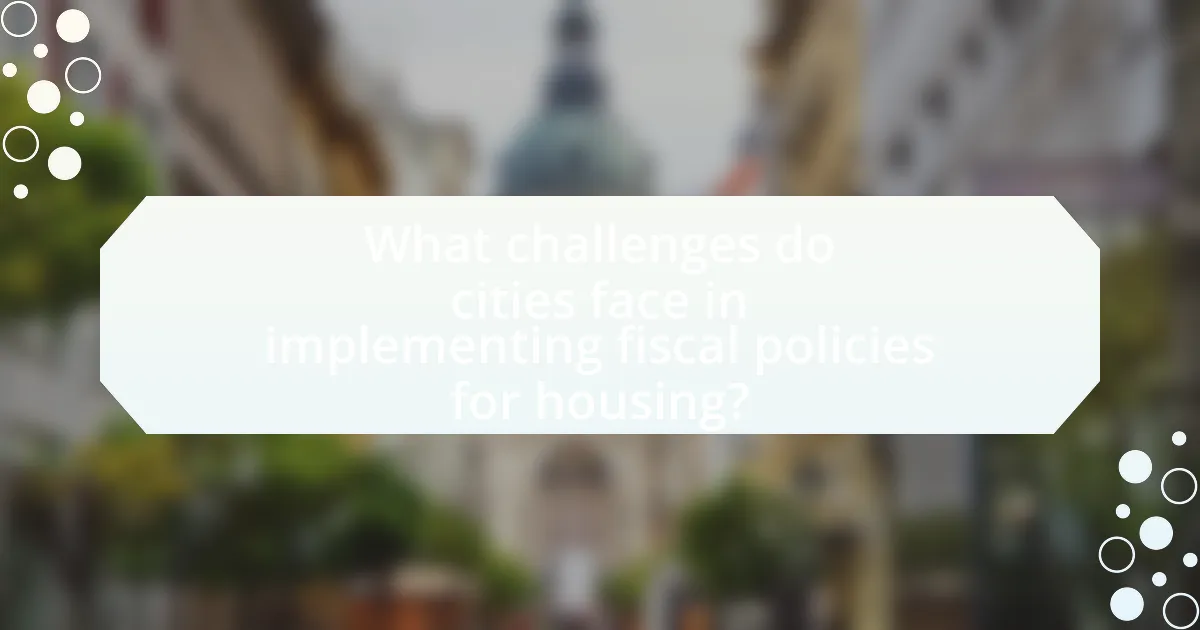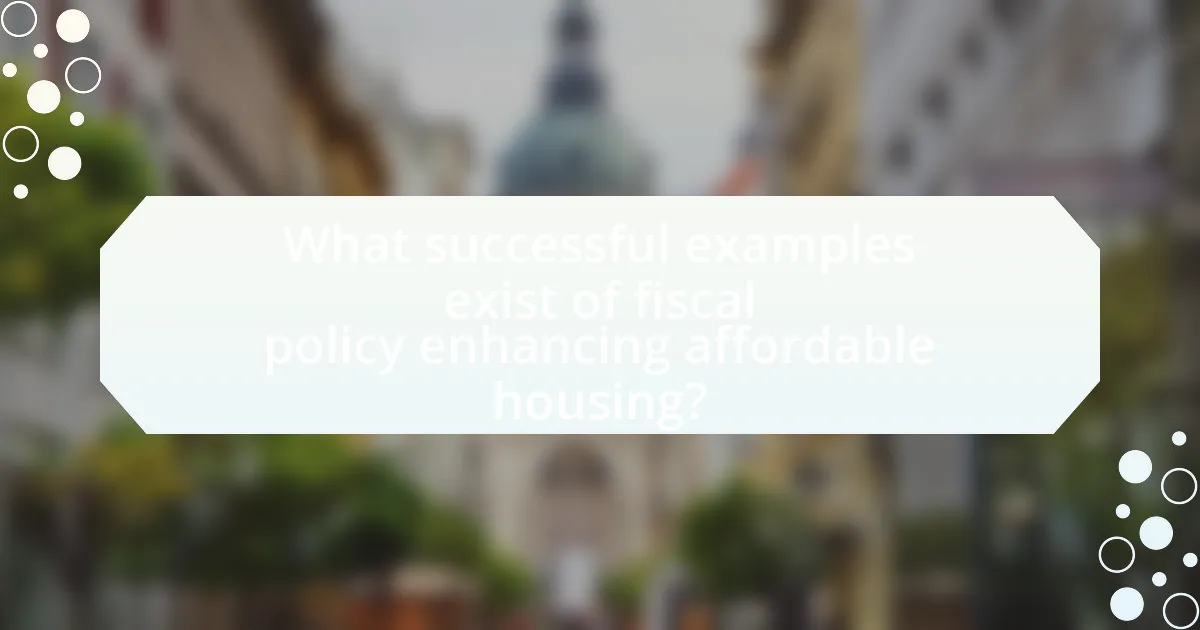Fiscal policy plays a crucial role in shaping affordable housing initiatives in major cities by influencing government spending, taxation, and subsidies that directly impact housing development. Key components such as tax incentives and public investment can stimulate the construction of affordable units, while budget constraints and political factors often pose challenges to effective implementation. The article examines the correlation between fiscal policy and housing outcomes, highlighting successful examples and best practices from various cities, as well as the social implications of inadequate affordable housing. It also discusses innovative funding mechanisms and the importance of public-private partnerships in addressing the affordable housing crisis.

How does fiscal policy influence affordable housing initiatives in major cities?
Fiscal policy significantly influences affordable housing initiatives in major cities by determining government spending and taxation levels that directly affect housing development. For instance, increased public investment in housing programs can lead to the construction of more affordable units, while tax incentives for developers can stimulate private sector participation in affordable housing projects. According to the National Low Income Housing Coalition, cities that implement policies such as tax credits or direct funding for housing projects see a measurable increase in affordable housing availability, demonstrating the direct correlation between fiscal policy and housing outcomes.
What are the key components of fiscal policy that affect housing?
The key components of fiscal policy that affect housing include government spending, taxation, and subsidies. Government spending on infrastructure and housing projects directly influences the availability and affordability of housing. For instance, increased funding for public housing initiatives can lead to more affordable units being built. Taxation policies, such as property taxes and tax incentives for developers, can either encourage or discourage investment in housing. For example, tax credits for low-income housing development can stimulate construction in underserved areas. Additionally, subsidies for first-time homebuyers can make purchasing homes more accessible, thereby impacting overall housing demand and prices. These components collectively shape the housing market by influencing supply, demand, and affordability.
How do tax incentives impact affordable housing development?
Tax incentives significantly enhance affordable housing development by reducing financial barriers for developers. These incentives, such as tax credits and deductions, lower the overall cost of construction and operation, making projects more financially viable. For instance, the Low-Income Housing Tax Credit (LIHTC) program has facilitated the creation of over 3 million affordable housing units since its inception in 1986, demonstrating the effectiveness of tax incentives in stimulating housing supply. Additionally, studies indicate that areas with robust tax incentive programs experience higher rates of affordable housing development compared to those without such measures, underscoring the critical role of fiscal policy in shaping housing initiatives.
What role do government subsidies play in housing affordability?
Government subsidies significantly enhance housing affordability by reducing the financial burden on low- and moderate-income households. These subsidies, which can take the form of direct financial assistance, tax credits, or grants, lower the effective cost of housing, making it more accessible. For instance, the Low-Income Housing Tax Credit program in the United States has facilitated the construction of over 3 million affordable housing units since its inception in 1986, demonstrating the tangible impact of such fiscal policies on housing availability. By providing these financial supports, governments can stimulate the housing market, encourage development in underserved areas, and ultimately contribute to a more equitable housing landscape.
Why is affordable housing a critical issue in urban areas?
Affordable housing is a critical issue in urban areas due to the increasing disparity between income levels and housing costs. As urban populations grow, demand for housing rises, leading to skyrocketing prices that outpace wage growth. For instance, a report from the National Low Income Housing Coalition indicates that in 2021, a worker earning minimum wage could afford only 1 in 4 rental units available in the U.S. This gap results in a significant portion of the population facing housing insecurity, which can lead to homelessness, increased poverty rates, and strain on social services. Furthermore, the lack of affordable housing exacerbates socioeconomic inequalities, making it essential for fiscal policies to address this issue through initiatives that promote affordable housing development and preservation in major cities.
How does population growth affect housing demand?
Population growth increases housing demand due to a larger number of individuals requiring living spaces. As more people move into an area, the need for residential properties rises, leading to higher competition for available housing. For instance, a study by the Urban Institute found that cities experiencing significant population increases, such as Austin and Seattle, have seen corresponding surges in housing prices and rental rates, indicating a direct relationship between population growth and housing demand. This trend often results in a strain on existing housing stock, prompting local governments to consider fiscal policies aimed at expanding affordable housing initiatives to accommodate the growing population.
What are the social implications of inadequate affordable housing?
Inadequate affordable housing leads to significant social implications, including increased homelessness, social instability, and heightened economic inequality. The lack of affordable housing options forces low-income families into overcrowded or substandard living conditions, which can exacerbate health issues and limit access to education and employment opportunities. According to the National Low Income Housing Coalition, in 2021, there was a shortage of 7 million affordable rental homes for extremely low-income renters, highlighting the severity of the crisis. This shortage contributes to social fragmentation, as communities become divided along economic lines, leading to increased crime rates and reduced social cohesion. Furthermore, inadequate housing can strain public resources, as governments may face higher costs related to healthcare and social services for those affected by housing instability.

What challenges do cities face in implementing fiscal policies for housing?
Cities face significant challenges in implementing fiscal policies for housing, primarily due to budget constraints, political opposition, and regulatory complexities. Budget constraints limit the financial resources available for housing initiatives, making it difficult for cities to allocate sufficient funds for affordable housing projects. Political opposition often arises from various stakeholders, including residents who may resist new developments or tax increases intended to fund housing initiatives. Additionally, regulatory complexities, such as zoning laws and building codes, can hinder the timely execution of housing policies, complicating the process of creating affordable housing options. These factors collectively impede the effectiveness of fiscal policies aimed at addressing housing needs in urban areas.
How do budget constraints limit housing initiatives?
Budget constraints limit housing initiatives by restricting the financial resources available for development, maintenance, and support of affordable housing projects. When government budgets are tight, funding for housing initiatives often faces cuts, leading to fewer projects being initiated or completed. For instance, a report from the National Low Income Housing Coalition indicates that in 2021, 7.4 million extremely low-income renters faced a shortage of affordable housing, largely due to insufficient funding from federal and state budgets. This financial limitation results in increased competition for limited resources, ultimately hindering the ability to address housing shortages effectively.
What are the effects of economic downturns on housing funding?
Economic downturns significantly reduce housing funding due to decreased investment and tighter credit conditions. During such periods, financial institutions often become more risk-averse, leading to stricter lending criteria and higher interest rates for mortgages. For instance, the 2008 financial crisis resulted in a 50% drop in mortgage lending, as banks faced substantial losses and tightened their lending practices. Additionally, government funding for housing initiatives typically declines during economic downturns, as tax revenues fall and budget deficits increase, further limiting resources available for affordable housing projects. This combination of reduced private investment and constrained public funding exacerbates housing shortages and affordability issues in major cities.
How do competing priorities within city budgets affect housing projects?
Competing priorities within city budgets significantly hinder housing projects by diverting funds to other essential services such as public safety, transportation, and education. For instance, when a city allocates a larger portion of its budget to police or fire services, less funding becomes available for housing initiatives, leading to delays or cancellations of affordable housing developments. According to the National Low Income Housing Coalition, cities that prioritize public safety over housing often experience increased homelessness and housing instability, demonstrating the direct impact of budgetary decisions on housing availability.
What political factors influence fiscal policy decisions regarding housing?
Political factors that influence fiscal policy decisions regarding housing include government ideology, party control, lobbying by interest groups, and public opinion. Government ideology shapes priorities; for instance, liberal administrations may prioritize affordable housing initiatives, while conservative ones may focus on tax incentives for developers. Party control affects legislative agendas, as majority parties can push through housing policies aligned with their platforms. Lobbying by real estate and construction industries can sway policymakers to favor certain fiscal measures, such as tax breaks or subsidies. Public opinion also plays a critical role; strong voter support for affordable housing can lead to increased funding and favorable policies. These factors collectively determine how fiscal policies are crafted and implemented in the housing sector.
How do local elections impact housing policy initiatives?
Local elections significantly influence housing policy initiatives by determining which candidates and parties gain power, thereby shaping local governance priorities. Elected officials often campaign on specific housing issues, such as affordable housing development, zoning regulations, and tenant protections, which directly affect policy outcomes. For instance, a study by the Urban Institute found that cities with progressive mayors are more likely to implement policies that promote affordable housing, reflecting the electorate’s preferences during local elections. Additionally, local elections can lead to shifts in funding allocations for housing programs, as newly elected officials may prioritize different initiatives based on their campaign promises and voter demands.
What role do advocacy groups play in shaping housing policies?
Advocacy groups play a crucial role in shaping housing policies by influencing legislation, raising public awareness, and mobilizing community support. These organizations often conduct research and provide data to policymakers, highlighting issues such as housing affordability and discrimination. For example, the National Low Income Housing Coalition regularly publishes reports that inform lawmakers about the housing crisis and advocate for increased funding for affordable housing programs. Additionally, advocacy groups engage in grassroots campaigns to rally public support, which can pressure local governments to adopt more equitable housing policies. Their efforts contribute to the development of policies that address the needs of vulnerable populations, ensuring that housing remains accessible and affordable.

What successful examples exist of fiscal policy enhancing affordable housing?
Successful examples of fiscal policy enhancing affordable housing include the Low-Income Housing Tax Credit (LIHTC) program in the United States and inclusionary zoning policies implemented in cities like San Francisco. The LIHTC program, established in 1986, incentivizes private developers to create affordable rental housing by providing tax credits, resulting in the construction of over 3 million affordable housing units nationwide. In San Francisco, inclusionary zoning mandates that a percentage of new residential developments be set aside for affordable housing, leading to the creation of thousands of affordable units since its implementation. These fiscal policies demonstrate effective government intervention in addressing housing affordability challenges.
How have specific cities effectively utilized fiscal policy for housing?
Cities like San Francisco and New York have effectively utilized fiscal policy for housing by implementing tax incentives and funding programs aimed at increasing affordable housing stock. San Francisco’s inclusionary housing policy mandates that developers allocate a percentage of new residential units for low-income residents, supported by tax credits that encourage compliance. Similarly, New York City has employed the 421-a tax exemption, which provides property tax benefits to developers who include affordable units in their projects, resulting in thousands of new affordable homes since its inception. These fiscal strategies demonstrate how targeted financial policies can directly influence housing availability and affordability in urban areas.
What lessons can be learned from successful case studies?
Successful case studies in affordable housing initiatives reveal that targeted fiscal policies can effectively increase housing supply and improve affordability. For instance, cities like San Francisco and New York have implemented tax incentives and zoning reforms that led to the construction of thousands of affordable units. Research shows that San Francisco’s inclusionary housing policy resulted in over 1,500 affordable units being built between 2014 and 2019, demonstrating the impact of strategic fiscal measures. Additionally, successful case studies highlight the importance of collaboration between government entities and private developers, which can streamline processes and enhance resource allocation. This collaborative approach has been pivotal in cities like Seattle, where partnerships have led to innovative funding solutions and increased housing availability.
How do public-private partnerships contribute to affordable housing?
Public-private partnerships (PPPs) contribute to affordable housing by leveraging resources, expertise, and funding from both sectors to create housing solutions. These collaborations enable the public sector to access private investment, which can accelerate the development of affordable housing projects. For instance, in cities like New York, PPPs have facilitated the construction of thousands of affordable units by combining public land and financing with private developers’ efficiency and innovation. According to the Urban Institute, such partnerships can reduce costs and increase the speed of project delivery, making affordable housing more accessible to low-income families.
What best practices can cities adopt to improve housing affordability?
Cities can adopt several best practices to improve housing affordability, including implementing inclusionary zoning, increasing funding for affordable housing projects, and streamlining permitting processes. Inclusionary zoning mandates that a percentage of new developments be set aside for affordable housing, which has been successfully implemented in cities like San Francisco, resulting in thousands of affordable units. Increasing funding for affordable housing can be achieved through dedicated taxes or bonds, as seen in Los Angeles, where a $1.2 billion bond measure was passed to finance affordable housing. Streamlining permitting processes reduces delays and costs for developers, encouraging the construction of more affordable units, a strategy effectively utilized in cities like Austin, which has seen a rise in housing supply as a result.
How can cities balance fiscal responsibility with housing needs?
Cities can balance fiscal responsibility with housing needs by implementing mixed-income housing policies that leverage public-private partnerships. These partnerships allow cities to utilize private investment to fund affordable housing projects while maintaining fiscal prudence. For instance, the inclusionary zoning policy in San Francisco mandates that developers allocate a percentage of new units for affordable housing, which helps meet housing demands without overextending public budgets. Additionally, cities can utilize tax incentives to encourage developers to build affordable units, thus aligning private interests with public housing goals. This approach not only addresses housing shortages but also ensures that cities remain financially stable by minimizing direct expenditures on housing initiatives.
What innovative funding mechanisms can support affordable housing initiatives?
Innovative funding mechanisms that can support affordable housing initiatives include social impact bonds, community land trusts, and public-private partnerships. Social impact bonds allow private investors to fund housing projects with the expectation of receiving returns based on the success of the initiative, which has been successfully implemented in cities like New York and Massachusetts. Community land trusts enable communities to acquire and manage land for affordable housing, ensuring long-term affordability and stability, as evidenced by successful models in Burlington, Vermont. Public-private partnerships leverage resources from both sectors to finance housing developments, exemplified by initiatives in Los Angeles that have resulted in thousands of affordable units. These mechanisms demonstrate effective strategies for addressing the affordable housing crisis in urban areas.

Leave a Reply